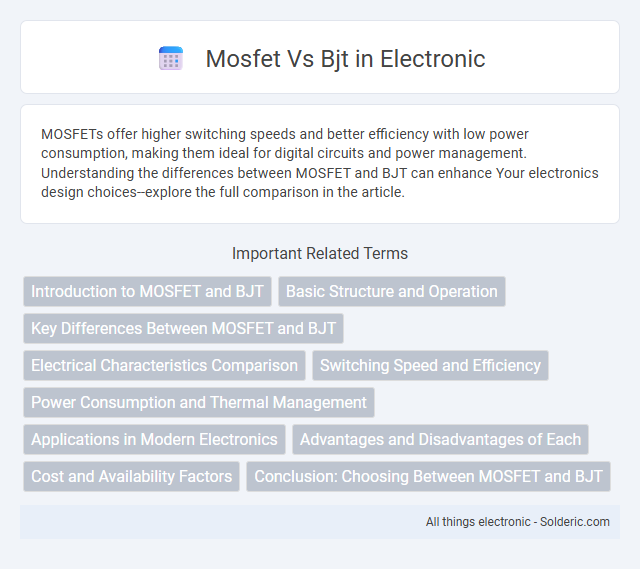MOSFETs offer higher switching speeds and better efficiency with low power consumption, making them ideal for digital circuits and power management. Understanding the differences between MOSFET and BJT can enhance Your electronics design choices--explore the full comparison in the article.
Comparison Table
| Feature | MOSFET | BJT |
|---|---|---|
| Type | Voltage-controlled device | Current-controlled device |
| Input Impedance | Very high (Megaohms to Gigaohms) | Low to moderate (Kiloohms) |
| Switching Speed | High-speed switching | Slower compared to MOSFET |
| Power Efficiency | Higher efficiency, low conduction losses | Lower efficiency, higher conduction losses |
| Thermal Stability | Better thermal stability | Prone to thermal runaway |
| Application | Power supplies, RF amplifiers, digital circuits | Amplifiers, switching circuits, analog devices |
| Control Terminal | Gate | Base |
| Operation Mode | Enhancement and depletion modes | Active, cutoff, saturation regions |
| Input Current | Negligible gate current | Requires base current |
Introduction to MOSFET and BJT
MOSFETs (Metal-Oxide-Semiconductor Field-Effect Transistors) and BJTs (Bipolar Junction Transistors) are two fundamental types of transistors widely used in electronic circuits. MOSFETs operate using voltage-controlled insulation layers to manage current flow, offering high input impedance and fast switching speeds, making them ideal for digital and power applications. BJTs, on the other hand, rely on current-controlled junctions, providing strong linear amplification and robustness in analog circuits and low-frequency applications.
Basic Structure and Operation
MOSFETs feature a gate insulated from the channel by a thin oxide layer, allowing voltage control of current flow between the source and drain terminals. BJTs consist of three layers of semiconductor material (emitter, base, and collector) where current flow is controlled by the base current. Your choice between MOSFET and BJT depends on whether you need voltage-driven operation with high input impedance (MOSFET) or current-driven operation with higher gain (BJT).
Key Differences Between MOSFET and BJT
MOSFETs (Metal-Oxide-Semiconductor Field-Effect Transistors) are voltage-driven devices with high input impedance, making them ideal for low-power applications, while BJTs (Bipolar Junction Transistors) are current-driven and typically offer higher gain and faster switching speeds. MOSFETs feature unipolar conduction and lower on-resistance, enhancing efficiency in power electronics, whereas BJTs rely on bipolar conduction and possess higher saturation voltage. Understanding your specific circuit requirements helps choose between the MOSFET's efficiency and the BJT's linear amplification capabilities.
Electrical Characteristics Comparison
MOSFETs exhibit high input impedance and low gate current due to their insulated gate structure, making them highly efficient for switching applications. BJTs have lower input impedance and require continuous base current to maintain conduction, resulting in higher power consumption. MOSFETs also offer faster switching speeds and better thermal stability, whereas BJTs provide higher current gain and better linearity in amplification tasks.
Switching Speed and Efficiency
MOSFETs exhibit faster switching speeds compared to BJTs due to their voltage-driven gate operation, which results in lower gate charge and reduced switching losses. MOSFETs achieve higher efficiency in high-frequency applications by minimizing conduction losses through low on-resistance (R_DS(on)), whereas BJTs suffer from higher saturation voltage and slower turn-off times. These characteristics make MOSFETs the preferred choice for power switching in modern DC-DC converters and high-speed switching circuits.
Power Consumption and Thermal Management
MOSFETs offer lower power consumption compared to BJTs due to their high input impedance and efficient switching capabilities, resulting in reduced gate drive losses. Thermal management is often simpler with MOSFETs because they exhibit lower on-resistance (R_DS(on)), which minimizes heat generation during operation. Your choice between MOSFET and BJT should consider these factors to optimize energy efficiency and maintain reliable thermal performance in your design.
Applications in Modern Electronics
MOSFETs dominate modern electronics due to their high switching speed, low power consumption, and efficient voltage control, making them ideal for digital circuits, power supplies, and RF amplifiers. BJTs are preferred in analog applications requiring high gain and linearity, such as audio amplifiers and radio frequency transmitters. Your choice between MOSFET and BJT impacts device performance in consumer electronics, automotive systems, and communication technologies.
Advantages and Disadvantages of Each
MOSFETs offer high input impedance and fast switching speeds, making them ideal for low-power and high-frequency applications, but they are more sensitive to static electricity and have a higher on-resistance compared to BJTs. BJTs provide better current handling capability and superior linear amplification with lower on-state voltage drop, yet they consume more power and have slower switching speeds due to their bipolar junction structure. Choosing between MOSFET and BJT depends on specific application needs such as efficiency, speed, and thermal performance.
Cost and Availability Factors
MOSFETs generally have a higher initial cost compared to BJTs due to their advanced fabrication process but offer greater efficiency and thermal stability, which can reduce overall system expenses. BJTs are widely available and cost-effective for low-power applications, benefiting from a mature manufacturing ecosystem with abundant supply. Availability of MOSFETs is increasing rapidly in various voltage and current ratings, driven by demand in modern electronics, making them competitive in both price and accessibility.
Conclusion: Choosing Between MOSFET and BJT
When choosing between MOSFET and BJT, consider that MOSFETs offer higher switching speeds, better efficiency, and lower gate current, making them ideal for high-frequency and low-power applications. BJTs excel in linear amplification with higher gain and robustness under high thermal stress, suited for analog circuits requiring precision. Your choice depends on factors like switching requirements, power dissipation, and circuit design complexity.
mosfet vs bjt Infographic

 solderic.com
solderic.com